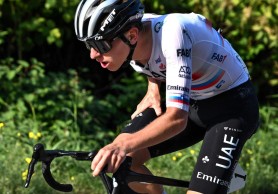How to prevent cramps while cycling
When facing a long and demanding bike ride, especially if it is at an intense pace, one of the cyclist's biggest fears is the appearance of cramps in the final stretch of the test. A reaction of the muscles when they can no longer manage fatigue and that can be tremendously disabling, forcing us to slow down and, in extreme cases, even preventing us from continuing on the bike.

Don't let cramps slow you down
Cramps, or "rampas" as they are known in some places in Spain, are defined as an intense and painful muscle contraction. When they occur involuntarily, the muscle contracts suddenly to the maximum, preventing movement and causing pain when trying to tense it beyond the mechanical range offered by the joint, and even more so when trying to stretch it back to its relaxed position.
Regarding what causes cramps, there is not a consensus among the scientific community, however, nowadays two main causes seem to be responsible for them either individually or in combination. We are talking about muscular fatigue that accumulates during long-duration efforts. On the other hand, the decrease in the concentration of electrolytes and fluids could also be responsible for cramps, necessary to carry out muscle contraction and to transmit nerve signals properly from the brain to the muscles to perform their movement.
RECOMENDADO

When do helmets have to be changed? Do they have an expiration date?

Some reasons to stay away from the road in winter

S-Works: what does it really mean and where does Specialized's most exclusive label come from?

The best apps for cycling and mountain biking

Black Friday 2025 cycling bargains: save on Garmin, POC, Maxxis and more

Black Friday Garmin 2025: the ultimate guide to choosing your GPS at the best price

When they appear on the bike, something that sooner or later will happen to you since not even professional cyclists are exempt from them on occasions, you have several options to deal with them. First of all, it is worth mentioning that cramps do not usually appear suddenly unless we make a sudden movement under conditions of great fatigue. Normally, they give warning signs with small twinges in the muscles and small contractions until, at a certain moment, with a slightly more intense effort, the affected muscle locks up and remains completely contracted.
Obviously, it is best not to reach that extreme and, when we perceive the warning signs, it is time to try to lower the intensity level, save efforts, especially those involving sudden movements, and try to make an extra contribution of salts. It is also very helpful to try to do small stretches on the bike as much as the pace and route allow.
However, if the muscle locks up completely, the options left are few. Getting off the bike and trying to stretch the muscle will be practically the only thing we can do in those moments that, normally, come accompanied by intense pain. The stretching must be very progressive until gradually the affected muscle returns to its relaxed position. In any case, once we suffer a severe cramp, we will be very limited when resuming pedaling and we will have to do it at a very gentle intensity to prevent them from reappearing.

As prevention measures, the first advice we can give you is to manage your efforts correctly. When facing a cycling event, it is very easy to get carried away by the rush of joining a good group. However, we must keep a cool head and be aware of our capabilities to avoid spending energy at the beginning that we may pay for at the end of the test unless, of course, our goal is to take risks to beat a certain time or win that challenge with a fellow cyclist. If you have a power meter, a good policy would be to plan power for the different sections and try to stick to it as much as possible.
Of course, maintaining good hydration and nutrition throughout the route is also key to delaying muscle fatigue as much as possible, especially the former where we will try to be rigorous by providing salts.
Also, the preparation we have throughout the year is crucial in the appearance of cramps. Obviously, the better our physical condition, the less likely we are to suffer from them. But, focusing on training, there seems to be a relationship between those cyclists who do a good strength work throughout the year and suffer fewer cramps.

And if, despite everything, cramps appear since not even professional cyclists are exempt from them on certain occasions, you can always apply the method that cyclists like Latchlan Morton or Tadej Pogacar have used and resort to pickle juice which seems to be an effective remedy to put an end to them once they appear.